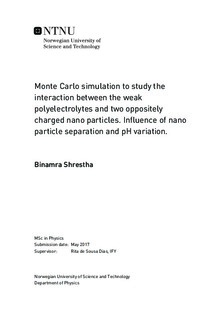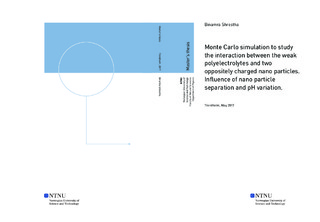Monte Carlo simulation to study the interaction between the weak polyelectrolytes and two oppositely charged nano particles. Influence of nano particle separation and pH variation.
| dc.contributor.advisor | de Sousa Dias, Rita | |
| dc.contributor.author | Shrestha, Binamra | |
| dc.date.accessioned | 2017-06-27T14:00:30Z | |
| dc.date.available | 2017-06-27T14:00:30Z | |
| dc.date.created | 2017-05-18 | |
| dc.date.issued | 2017 | |
| dc.identifier | ntnudaim:14349 | |
| dc.identifier.uri | http://hdl.handle.net/11250/2447081 | |
| dc.description.abstract | Primitive model of electrolyte is used as it provides a good basis for the statistical mechanical description of the charged colloids. The colloidal solution on aqueous form is represented by the mixture of hard spheres differing in charge and size. The solvent enters the solution only through its relative permittivity. The solution containing only the charged colloids and their counterions with a polyelectrolyte chain (PE), forming electroneutral system are studied. The colloids are referred as nano particles (NPs). Monte Carlo (MC) simulation are performed at 298 K in the grand canonical ensemble according to the Metropolis algorithm. An off-lattice three-dimensional coarse grained model is used to describe the system. The solvent is treated implicitly as a dielectric medium with a relative permittivity constant ϵr = 78.4. This work is focused on the interaction of weak (PEs) with two like charged colloids NP. Polyelectrolytes are polymers with charged monomers. It is a flexible chain with the harmonic bonds with each monomer. It is classified as weak because the charge in every monomer are extremely sensitive to the pH of the solution. The charge of the PEs can also very in the presence of NPs. It is found that the inflection point is lowered substantially in the presence of NP. One of the focus of the study is the adsorption of the PEs to the NP surface. We have found in our study that the weak PEs adsorbed to the NP more than the strong PEs. This is primarily due to the possibility of the charge distribution along the PEs chain. We have found that the total charge of the PE chain in presence of NPs disregarding the variation of NP separation is constant. In the other hand the charge distribution within the monomers is not uniform. The monomers which are in the vicinity of the NP surface tend to have more charged state and the electrostatic force between the NP and the charged monomer is substantial for the adsorption. Thesis explains this is much more depth. The mean force between the NPs is another objective of the study. Mean force between the like charged NPs in the presence of monovalent counterions is always repulsive. Past researches have shown that the presence of the multivalent counterion can induce attractive force between the like charged NP. In our study, we have found that presence of weak PE can also induce the attractive force between the NPs and that can stabilize the solution. Point to note here is that the monomers are also monovalent as counterions. The main contributor of the attractive force is the bond force in the PE chain. The counterion correlation also contribute to the attractive force but is not enough to induce the attraction. The force arising from harmonic bond effectively lowers the repulsive force and stabilize the system. The attractive is seen for small separation of the NPs as with the multivalent counterion. | |
| dc.language | eng | |
| dc.publisher | NTNU | |
| dc.subject | Physics (MSPHYS) | |
| dc.title | Monte Carlo simulation to study the interaction between the weak polyelectrolytes and two oppositely charged nano particles. Influence of nano particle separation and pH variation. | |
| dc.type | Master thesis |
Tilhørende fil(er)
Denne innførselen finnes i følgende samling(er)
-
Institutt for fysikk [2677]

